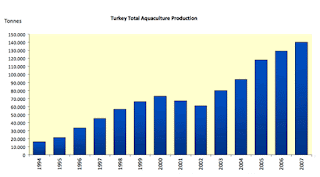Turkey’s overall aquaculture production in 2007 was 139 873 tonnes.
The first aquaculture farm in Turkey, in inland waters for the culture of rainbow trout, was started in 1971 and today there are 1715 operating farms with a production capacity of 199360 tonnes per year of which 350 are marine farms with a production capacity of 110840 tonnes. Marine aquaculture did not get started however until 1985 and the aquaculture sector as a whole developed mainly in the 1990s with the production of European seabass and gilthead seabream in the Mediterranean; rainbow trout, Atlantic salmon and European seabass in the Black Sea; mussels in the northern Aegean and the Sea of Marmara; and recently turbot in the Black Sea. It is estimated that the aquaculture sector in Turkey provides employment (direct and indirect) for about 25 000 people in mostly rural areas.
Figure 1 – Turkey: Distribution of aquaculture production for main species (volume), 2007
Figure 2 – Turkey: Distribution of aquaculture production by main species group (value), 2007
The rapid growth of the sector in Turkey was driven by a growing demand for fish, the availability of sheltered sites and good water quality, government subsidies relatively flexible regulations for licensing, high private sector interest and low labour cost. Even with a relatively low domestic per capita consumption of 8.19kg of fish, the size of Turkey’s population, 71.6 million in 2007 combined with its annual rate of growth of 1.06 percent and growth of 6.7 percent in per capita income translates into a large and growing domestic market for seafood products. There are currently 20 operating marine hatcheries producing around 332 million European seabass and gilthead seabream juveniles annually with additional imports in 2007 of 25 million juveniles to satisfy domestic production needs. In contrast to the production side, the hatchery industry is highly concentrated with the largest company operating three hatcheries with an annual production capacity of 200 million juveniles. Three other companies control six hatcheries with a combined production of 130 million juveniles.
Figure 3– Turkey: Aquaculture production, 1994–2007
The biggest issue for the future of Turkish aquaculture is the competition for space, specifically the 2006 decision by the Ministry of the Environment to exclude marine cages from enclosed bays and near shore areas. When applied, this would result in the great majority (85 percent) of current cage farms moving to offshore areas. Although enforcement of the decision has been delayed many times, it is clear that the period of uncertainty combined with the current industry and economic crisis will result in an important restructuring of the industry. Small farms cannot at present afford the cost of moving their cages to offshore installations as well as the investment in infrastructure required. Those larger companies which will be able to weather the double industry and financial crisis should be better positioned to adapt to the new situation and perhaps gain a competitive advantage in the long run through more concentrated and efficient installations.









0 comments:
Post a Comment